This episode is all about saliva: how certain bacteria survive in it, and how swallowing saliva might cause intestinal inflammation.
The TWiM hosts and associated microbiomes review a fungus destroying salamanders in Europe, and genes for flagella in intracellular bacteria.
From the TWiM team, a discussion of Hurricane Harvey microbiology, and a bacterial enzyme that induces eukaryotic mating.
The TWiM team provides an update on Zika virus, and reveals a plasmid on the road to becoming a virus.
The TWiM team pays a tribute to Chris Condayan, and investigates the synergy between virus and the innate immune system for clearing bacterial pneumonia by phage therapy.
The TWiM team considers a report on prokaryotic viral DNA in mammalian brain, and how diarrhea is beneficial, by clearing enteric pathogens.
The TWiMbionts explore the role of bacteria in genesis of moonmilk, and how ancient host proteins can be used to engineer resistance to virus infection.
The TWiM team explains the use of microbial genome mining to identify new drugs, and how a bacterial symbiont protects flies against parasitoid wasps.
Michele updates the TWiMers on Legionella in the Flint water supply, and Elio informs us about how horizontally acquired biosynthesis genes boost the physiology of Coxiella burnetii.
At Microbe 2017 in New Orleans, the TWiM team speaks with Arturo Casadevall about his thoughts on the pathogenic potential of a microbe, rigorous science, funding by lottery, and moonshot science.




